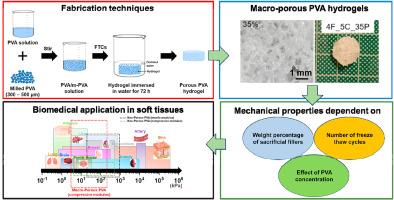为生物医学应用定制大孔 PVA 水凝胶的机械特性。
IF 3.3
2区 医学
Q2 ENGINEERING, BIOMEDICAL
Journal of the Mechanical Behavior of Biomedical Materials
Pub Date : 2024-11-06
DOI:10.1016/j.jmbbm.2024.106787
引用次数: 0
摘要
聚乙烯醇(PVA)是一种具有生物相容性的生物聚合物,与胶原蛋白和明胶等天然生物材料相比,它具有优异的尺寸稳定性和机械稳定性。此外,水凝胶形式的 PVA 在机械加载过程中表现为非线性,会产生类似于软生物组织的反应。一般来说,PVA 水凝胶是通过冻融循环(FTC)制成的,改变冻融循环的次数可以控制其机械性能。水凝胶的孔隙率是决定其机械特性的另一个重要因素,在生物软组织中也很明显。在 PVA 水凝胶中加入大孔可大大降低材料的硬度,并能模拟一些多孔组织,如肺、肝、骨髓、肾和阴茎组织(海绵体和海绵体)。在这项研究中,我们利用冻融工艺,然后通过牺牲性三维打印和研磨 PVA(m-PVA)填料颗粒的微粒浸出,开发出了大孔 PVA 水凝胶。这种制造方法可以控制大孔 PVA 水凝胶中的孔隙率,这不仅对调整机械性能至关重要,而且对模仿海绵状组织(如肝脏组织和阴茎海绵体)的结构也很重要。我们使用光学显微镜调查了试样中的孔隙率水平,以了解孔隙的分布和孔隙大小。PVA 水凝胶机械性能的可调性是本研究的一项重要发现,它是通过三个因素实现的:(i) 牺牲填料的重量百分比;(ii) FTC 的数量;(iii) PVA 的浓度。这些大孔 PVA 试样具有广泛的生物医学应用前景,可用作生物软组织类似物或组织工程支架,其中 PVA 水凝胶可进行调整以符合这些生物软组织的机械性能。本文章由计算机程序翻译,如有差异,请以英文原文为准。

Tailoring the mechanical properties of macro-porous PVA hydrogels for biomedical applications
Polyvinyl alcohol (PVA) is a biocompatible biopolymer with superior dimensional and mechanical stability when compared to naturally available biomaterials such as collagen and gelatin. Furthermore, PVA in hydrogel form behaves non-linearly during mechanical loading, generating a response like soft biological tissues. Generally, PVA hydrogels are fabricated using freeze-thaw cycles (FTCs) and changing the number of FTCs gives control over its mechanical properties. Porosity of the hydrogel is another important factor which determines its mechanical properties and is also evident in biological soft tissues. Incorporating macro-pores in PVA hydrogels substantially reduces the stiffness of the material and can mimic some porous tissues such as lung, liver, bone marrow, kidneys, and penile tissues (corpus cavernosa and spongiosum). Within this study, we developed macro-porous PVA hydrogels using the freeze-thaw process followed by particulate leaching of sacrificial 3D-printed and milled PVA (m-PVA) filler particles. This fabrication method enables control over the porosity in macro-porous PVA hydrogels, which is crucial not only for tuning mechanical properties but also for mimicking the structure of spongy tissues, such as liver tissue and corpus cavernosum in the penis, for example. We investigated the level of porosity in the specimen using optical microscopy to understand the distribution of the pores and the pore size. The tunability of the mechanical properties of PVA hydrogels is a key finding of this study and is achieved using three factors: (i) weight percentage of sacrificial fillers, (ii) number of FTCs and (iii) concentration of PVA. These macro-porous PVA specimens have wide ranging biomedical applications as biological soft tissue analogues, or tissue engineering scaffolds, where the PVA hydrogel can be tuned to match the mechanical properties of these soft biological tissues.
求助全文
通过发布文献求助,成功后即可免费获取论文全文。
去求助
来源期刊

Journal of the Mechanical Behavior of Biomedical Materials
工程技术-材料科学:生物材料
CiteScore
7.20
自引率
7.70%
发文量
505
审稿时长
46 days
期刊介绍:
The Journal of the Mechanical Behavior of Biomedical Materials is concerned with the mechanical deformation, damage and failure under applied forces, of biological material (at the tissue, cellular and molecular levels) and of biomaterials, i.e. those materials which are designed to mimic or replace biological materials.
The primary focus of the journal is the synthesis of materials science, biology, and medical and dental science. Reports of fundamental scientific investigations are welcome, as are articles concerned with the practical application of materials in medical devices. Both experimental and theoretical work is of interest; theoretical papers will normally include comparison of predictions with experimental data, though we recognize that this may not always be appropriate. The journal also publishes technical notes concerned with emerging experimental or theoretical techniques, letters to the editor and, by invitation, review articles and papers describing existing techniques for the benefit of an interdisciplinary readership.
 求助内容:
求助内容: 应助结果提醒方式:
应助结果提醒方式:


